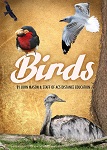
Superorder: Neognathae
Order: Piciformes
Families: 5
Species: 396
Examples: Toco Toucan, Collared Aracari, Coppersmith Barbet, Yellow-fronted Tinkerbird, Eurasian Wryneck, Greater Honeyguide, Red-headed Woodpecker, Cardinal Woodpecker, Northern Flicker, Rufous-tailed Jacamar, Swallow-winged Puffbird, Lesser Goldenback
Distribution: Commonly forest dwellers inhabiting temperate areas widely spread around the world (Woodpeckers are an exception as they do not live in Australasia, Antarctica, Greenland or Madagascar).
Anatomy: Piciformes have four strong toes: 2 forward and 2 hind (exceptions include some woodpeckers which can have 3 toes instead), pointed tail feathers and lack down feathers. Although all birds from this order have strong bills, its physical appearance is distinguishable: Toucans, for example, have large coloured bills; Woodpeckers have long and sharp bills; Barbets have short bills. Woodpeckers have strong neck muscles and thick skulls due to their habit of drilling into trees. Birds from this order vary in size and weight: some of the smaller species such as the Rufous Picolet, can weigh around 9gr and grow up to 9cm ; while larger species like the Toco Toucan can weigh up to 850gr and grow as much as 60cm in length.
Diet: Insectivorous (i.e. termites, ants, butterflies, dragonflies, however, some base their diets mainly on fruits. Some eat small reptiles or rodents.
Behaviour: the majority of them are non-migratory birds. Mainly arboreal and solitary, however, some are gregarious (i.e. Acorn Woodpeckers) and some have developed a terrestrial pattern (i.e. Ground Woodpeckers).
Breeding: mainly cavity nesters, although some nest in tunnels (i.e. Jacamars and Puffbirds); Honeyguides are brood parasites while woodpeckers drill their own hollows. They generally lay between 1 (i.e. Honeyguides) to 8 (i.e. Woodpeckers) eggs and the incubation period lasts between 12-19 days, depending on the species; the chicks are born artricial. Toucans live approximately 20 years.
Main predators: Jaguars and other large felines; birds of prey such as hawks and owls.
Human interaction: Mainly threatened by human encroachment and deforestation or other types of habitat destruction
Interesting facts: Honeyguides are the only birds in the world able to digest beeswax.
If you want to read more on Birds, we download our
Bird ebook. We also have an
Ornithology course.